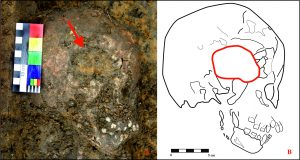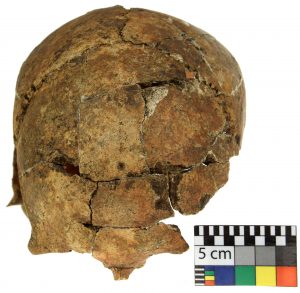Climate and violence
Climate and violence
Wars and ritual events in the past
As well as birth, peace and balance, also acts of violence, war, conflicts and last but not least traditional rituals (bloody or not) supported by faith, religion and ideology have been a part of our lives since the beginnings of the human kind. Archaeological and historical records inform us about this kind of events repeatedly at different levels from prehistoric cave and rock paintings to written records describing war events, battles, victims of violence and religious offerings. We can notice these events at several levels of archaeological context, either indirectly (iconography, weapons and their fragments, armaments and written sources) or directly through many archaeological finds and contexts, such as buried or just carelessly thrown bodies with traces of violence (including shot/murdered famous mummy called Ötzi found in Tyrolian Alps), mass burials in settlement, funeral and sacral contexts, bone remains of slaughtered individuals, proofs of ritual anthropophagy or direct consequences of war or ritual events, such as cult scenes and sacral areas with bloody offerings. As causes of these events we can imagine political interests of ruling social classes, fights for land, hegemony, water, food, other sources or raw materials necessary for a survival. These evidences of violence, war and ritual events in the past will be analysed in a frame of this project.
The main research questions of this project are: Whatever the causes of the acts of violence in the past were, are we able to arrange them according to defined criteria (in terms of time or geographically), do they accumulate in certain periods or regions? Are we able to connect these events temporally with distinct or long-term climate changes? A way to answer this question is to collect and analyse sufficient number of proxy data concerning climatic and environmental conditions (paleoclimatic data, isotopes of carbon, nitrogen, oxygen and strontium, archaeobotanical, paleoenvironmental and archaeogenetic data, absolute dating). Sampling should be done from distinct archaeological and comparable paleoenvironmental contexts and the proxy data from these two context types should be mutually compared. At the same time, it is necessary to analyse social structures of specific archaeological cultures with its habits, subsistence and raw material strategies during the particular researched period. This information can be used for a cognition of causes and reasons of patterns of behaviour leading to acts of violence. If the mutual influence of researched acts of violence and climate oscillations was proved, it would be a clear evidence that climate changes belong to a group of important factors stimulating and strongly influencing human behaviour. It would also mean that climatic factors belong to the indicators and perhaps to the starting elements of these basically negative violent prehistoric and historic events, which could influence human history for quite a long time.
The main result of this project will be the analysis of archeologically evidenced examples of violent behaviour caused by wars or bloody rituals in the area of current Czech Republic, which will enable a comparison with other countries. Integral outputs of this projects will be scientific publications in impacted journals as well as popular presentation of this topic in a form of exhibitions or lectures for non-specialist audience.

Horní Moštěnice – Příčky site (Epi-Corded Ware Cultural Complex) in Central Moravia, example of a lethal injury on the skull caused by a blunt hit. Photo by L. Šín.

Mikulovice Bronze Age site in eastern Bohemia, example of a healed injury on the skull caused by a stab by a sharp weapon. Photo by L. Šín.





